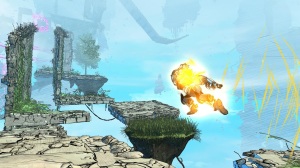Cloudbuilt almost lost me in the first 10 minutes.
The cursors for the menus on the title screen only appear once you press up or down. “No big deal, I thought, it’s a very small issue and this is an indie game—probably not a huge dev team.” But 5 minutes into the tutorial and the default controls (for a controller) were strange and unfamiliar. RB to jump? A Button to drop off a ledge? I figured I’d remap the controls to something more familiar. And that’s where the game almost lost me. The keymapping menu is hellish to navigate until you figure it out. To me this screamed of an indie game that didn’t take enough time to polish their experience. Didn’t anyone playtest this? Eventually I got the controls figured out and started actually playing the game.
I’m so glad I gave it a chance.
Cloudbuilt is genuinely fun. It’s the perfect flow game—a wonderful blend between fast-paced and relaxing. You play Demi, a former soldier trapped in a coma, as she grapples with her trauma and dreams of her days wall-running, rocket boosting, and shooting her way through beautiful sky-ruins. It’s everything I’ve wanted all of the recent Sonic games to be, but with a great female protagonist and a beautiful backdrop.
I was clearly wrong about the playtesting. Cloudbuilt is a marvelous experience that’s been finely tuned to maximize flow. Its parkour mechanics rely heavily on well-designed levels. It’s easy to pick up, but quickly throws the player into challenging puzzles. The difficulty curve felt a tad abrupt in places, but always in a way that suggested I was missing a key technique (and I usually was). I died a lot, but almost always with a smile.
In games in which the player dies a lot, it’s important to make dying feel less punishing. Much like with Super Meat Boy, I found myself shaking my head and laughing at the pure absurdity of what a level expected me to do. I overcame seemingly impossible levels to find crazier challenges awaiting me on the next map. More than just minimizing friction with its key-bound “restart from last checkpoint” button, Cloudbuilt manages to actually make dying pleasurable through Demi’s soundbites when she dies.
Demi has a surprising amount of character from these in-level soundclips. When she falls off a cliff or runs out of boost-energy she lets out a pleading “not now” or an exasperated “dammit” without it feeling overdone or childish. She feels real. In fact, she says the same things I was usually screaming at my screen as I slid off a wall into the cloudy abyss.
But for all of the character she had during the missions, her between-level narratives needed work. Between levels, the player is transported to Demi’s recovery room where we maintain control of our character as a mangled Demi lies in a coma while a voice-over waxes poetic about trauma, ethics, ruin, and war. In theory, the concept is interesting. But in practice the writing was overwrought, and the voice actress had a hard time keeping it believable.
 I loved the initial shock of seeing myself lying, head half-shaved and bandaged, arm severed, and reflecting on the pain of leaving a military life—wondering how to readjust, dealing with the trauma of battle, and worrying it will follow you forever. This was not the spunky girl from the levels! And while at first I found her backstory intriguing—since we so rarely see vulnerable, complicated female protagonists, much less women in sustained pain—eventually I started resenting the injustices the writing did to the parts I loved about Demi’s character.
I loved the initial shock of seeing myself lying, head half-shaved and bandaged, arm severed, and reflecting on the pain of leaving a military life—wondering how to readjust, dealing with the trauma of battle, and worrying it will follow you forever. This was not the spunky girl from the levels! And while at first I found her backstory intriguing—since we so rarely see vulnerable, complicated female protagonists, much less women in sustained pain—eventually I started resenting the injustices the writing did to the parts I loved about Demi’s character.
Cloudbuilt serves as a great example of the difference between narrative design and writing. I loved the ability to retain control of my character while a voice-over gave me exposition. I could skip this at any time by physically moving to a different area. It felt optional in a way that cutscenes don’t. While at first I thought that it would have been nice to have more to do while I was listening, the lack of options meant that listening to my own backstory was deliberate and attentive; I was there because I wanted to be. I was listening because I chose to. And the story was good. Games don’t address the trauma of combat nearly enough. But the words themselves weren’t believable. I couldn’t reconcile the written voice with the character I had built in my mind, the girl who cursed when she failed. Cloudbuilt has great narrative design, but lackluster writing.
Still, Cloudbuilt’s pleasure experience is not in the writing; it’s in the gameplay. Its ambitious approach to its narrative subject should be applauded, even if the words themselves came up a little short, because the real art is in the design.
Incidentally, I did figure out why they chose such unconventional controller mapping: this is not a game meant to be played on controller. It presumes free movement of the camera while running and jumping, something that’s trivial with mouse and keyboard, but much more difficult when you have to take your thumb off of A-button mid-jump to use the look stick. The devs were right all along.
This team seems incredibly promising. I’m genuinely excited to see how their future projects turn out.


